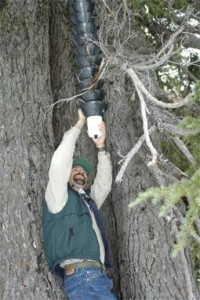Scientists gather to save pines
Herald and News
Klamath Falls, Oregon
October 09, 2005
By LEE JUILLERAT
Crater Lake – A tree species that’s regarded as a survivor isn’t.
Whitebark pines, the slow-growing, usually wind-twisted trees found at heavily visited areas of Crater Lake National Park, are often admired for their beauty and their ability to survive in high, harsh climates.
Trouble is, they aren’t surviving.
Scientists gathered at the park last week to figure out how to save the trees. And they said the situation is grave.
”The concern is the loss of the species,“ said Sheila Martinson, the geneticist for the Forest Service’s regional office in Portland.
At Crater Lake, whitebarks are dominant along the promenade, the walkway between Rim Village and Crater Lake Lodge seen by most of the park’s half-million yearly visitors.
The whitebarks, with the lake and Wizard Island in the background, are often photographed. But few of the trees are living. Most are dead or dying.
”Whitebark pine are considered part of our cultural landscape, especially up at Rim Village,“ says Michael Murray, the park’s terrestrial biologist.
Murray, Martinson and 35 other biologists gathered at the park Tuesday through Thursday to discuss threats to whitebark pines. The gnarly trees typically grow in remote high elevation areas of the Pacific Coast and Rocky Mountains. But at Crater Lake they’re part of the visual landscape.
”That’s why these high-altitude national parks are so important, because people can see what’s happening,“ said Diana Tomback, a University of Colorado biology professor and chair of the Whitebark Pine Ecosystem Foundation.
”Whitebark are not just another conifer,“ said Richard Sniezko, a Forest Service geneticist, who says whitebarks also play an important role in holding snow, preventing erosion and serving as ”nurse“ trees that provide shade for other tree species.
American Indians harvested and ate the seeds, which are high in protein and fat.
At Crater Lake, dying whitebarks are easily seen in Rim Village and popular viewpoints along West Rim Drive. Around the Klamath Basin, it requires a greater effort to view whitebarks at places such as Pelican Butte, Mount McLoughlin, Goosenest and Mount Shasta.
The whitebarks are victims of blister rust, a non-native disease that arrived in North America nearly 100 years ago. Blister rust attacks pines whose needles come in clusters of five. It can kill them outright, or weaken them enough to leave them vulnerable to Western pine beetles. In some areas of the northern Rocky Mountains, mortality has been estimated at 90 percent and higher.
Tomback isn’t ready to pronounce the whitebarks doomed. She’s concerned – ”This will change the face of western forests“ – but focuses on ways to regenerate healthy whitebarks, such as harvesting seeds from surviving whitebarks and either planting the seeds or nurturing and transplanting seedlings.
”We’re just trying to help nature out,“ Tomback said. ”We’re all still learning about restoration.“
John Schwandt, from the Forest Service’s forest health project in Coeur d’Alene, Idaho, said replanting efforts will mimic the action of of Clark’s nutcrackers, one of the many species such as bears and squirrels that depend on the trees for food.
The birds harvest whitebark seeds, bury them in disturbed areas and later retrieve some of those seeds. The forgotten seeds germinate. The relationship that contributes to the survival of both bird and tree dates back hundreds of thousands of years.
”We want to do a better job than nutcrackers,“ Schwandt said.
Schwandt is spending a year coordinating efforts aimed at compiling data about whitebark health in an area that extends from northern Canada to the Sierra Nevadas, and recommending restoration plans.
Whitebarks, which live hundreds of years, are considered established at five years, when they are only about 8 inches tall. They produce seeds after 50 years or more.
”We are looking at decades,“ Tomback said. ”This is a process that was a century in its development.“
”People ask, ‘Why don’t you just let nature take its course?’ “ Sniezko said.
Because blister rust is an exotic disease, he said, whitebarks have little resistance. Research indicates the odds of surviving may be one in 100 or one in 10,000.
”This is a very low level of resistance,“ Sniezko said.
Among the recovery projects under way:
Whitebarks will be planted next summer as part of the Rim Village rehabilitation project that’s removing the parking lot between the rim and the cafeteria gift shop and creating a pedestrian walk-way.
Murray is overseeing efforts to collect seeds from surviving whitebarks. Seeds from 10 trees were taken in 2003 and from another 30 trees this past summer. Collected seeds are sent to Sniezko’s genetic resource center for study to determine if they are disease-free and, if so, they are planted
Funnel traps are on two trees, one near Rim Village, another near Llao Rock, collect mountain pine beetles, another threat to whitebark pine and other tree species’ health.
Tomback hopes that affected national forests will each eventually include upward of $10,000 in their annual budgets for whitebark maintenance. At present, $130,000 is being spent in Oregon and Washington to jump-start whitebark programs, while another $360,000 has been allocated for resistance breeding.
”There’s a fair amount of energy and money being put into whitebark needs,“ said Doug Droust, the Forest Service’s forest health director for Oregon and Washington.
For information on the Whitebark Pine Ecosystem Foundation visit www.whitebarkfound.org. For information on the Crater Lake Institute visit their Web site at www.craterlakeinstitute.org or write Crater Lake Institute, P.O. Box 2, Crater Lake, OR 97604.
Other pages in this section


